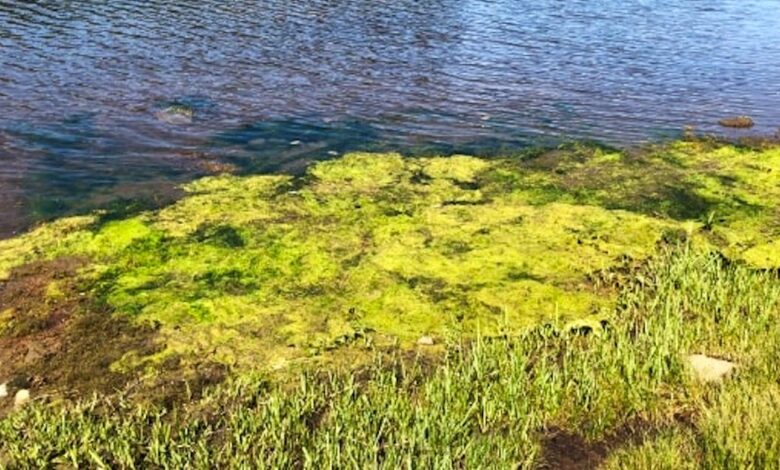It’s not necessary to stay out of all the water, but be careful as reports of blue-green algae are on the rise

Blue green algae continues to appear in lakes across the county.
The Halifax Regional Municipality closed Cunard Lake Beach in Williams Lake Thursday morning due to a bloom of the toxic algae, which can make people sick and kill pets in a short period of time.
The message also follows a note to customers at Halifax Veterinary Hospital that a dog died after spending five minutes in the waters of Long Lake in Hammonds Plains on June 16. showed epileptic activity. She went (en route) to the emergency hospital about 2 hours after leaving the water.”
The results of the incident were sent to the vet by the provincial Ministry of Agriculture on Wednesday afternoon.
As of late June, 12 more lakes in the province have been identified as containing the algae. But Elizabeth Kennedy, the director of the Department of Environment and Climate Change’s water division, said Friday that people should be wary, but that doesn’t mean they should avoid all water out of fear.
“I don’t think advising people to stay out of the water is what we want to do,” Kennedy said. “Before blue-green algae, every time you swam in lakes or rivers you were at risk of exposure to bacteria, protozoa and other water safety issues,” she said. “Blue green algae is an additional risk, but not necessarily a greater risk.”
However, she should all be vigilant and avoid areas where it is seen. If someone develops symptoms, such as a skin rash, headache, or abdominal pain, it could be because of blue-green algae or other toxins that were always there.
The main problem is with pets, who are attracted to the smell and are likely to eat the algae and become extremely or fatally ill.
The mats can also wash up on shore, so pet owners should make sure their pets don’t eat or roll in them there either.
Kennedy said people should make their own choices about how to reduce the risk of their dog getting into the algae, for example, keeping them at home, keeping them out of the water completely or keeping them on a leash until they can look at an area and see if there are algae mats in the water where they plan to let the dog swim.
“We want to let people know what to look for and what the risks are and what the downsides are,” she said. “A blanket recommendation for managing that risk isn’t going to work for everyone… the most important thing is to be really vigilant about what your dog is doing when he’s in or near the water.”
Blue-green algae occur naturally in freshwater environments and can grow when weather conditions are calm and warm. Some species of blue-green algae produce toxins that can pose a risk to pets and humans.
People should avoid any contact with water where the algae is present, including swimming and wading, keeping pets on a leash and out of the water, and not consuming lake water or fish.
At the end of June, the number of lakes with reports of blue-green algae was higher than at the same time in 2022, but the provincial environmental department said that doesn’t necessarily mean it’s in more lakes, just that it’s being reported more often as more people realize it.
People who come into contact with blue-green algae blooms or ingest water containing blue-green algae blooms may experience skin irritation, rash, sore throat, sore red eyes, swollen lips, fever, nausea, vomiting and/or diarrhoea. Children and immunocompromised individuals are at higher risk. If you have these symptoms, seek medical attention.
When a bloom or mat is observed, a beach closure is issued and testing is done first to determine if the algal bloom will produce toxins. If the algal bloom produces no toxins, no further testing is needed and the beach will reopen.
If the algal bloom is dangerous, more tests are conducted and the beach remains closed until the blooms are gone and the post-bloom test results indicate that the toxin concentration in the water is within safe limits, as determined by Health Canada.
HR has more information about blue-green algae online.
Provincial announcements are published on the website of the Department of the Environment.
If blue-green algae are present:
- do not drink, swim, bathe, shower or brush your teeth with the water
- do not allow children, pets or livestock to drink or swim in the water
- if you come into contact with blue-green algae, wash yourself and all items that have come into contact
- use alternate water sources for drinking, cooking, bathing, washing, and watering vegetables (contaminated water is not safe even if boiled, filtered into a pitcher or pitcher, or treated with bleach, herbicides, copper sulfate, or other algicides)
- be careful with recreational water activities that create mist (such as boating) because the toxins can be inhaled
- be careful about eating fish caught in waters where blue-green algae blooms occur (do not eat the liver, kidneys or other organs as the toxins can be stored there)
- if you get sick, seek medical help
- if your pet ingests blue-green algae, contact a vet immediately




